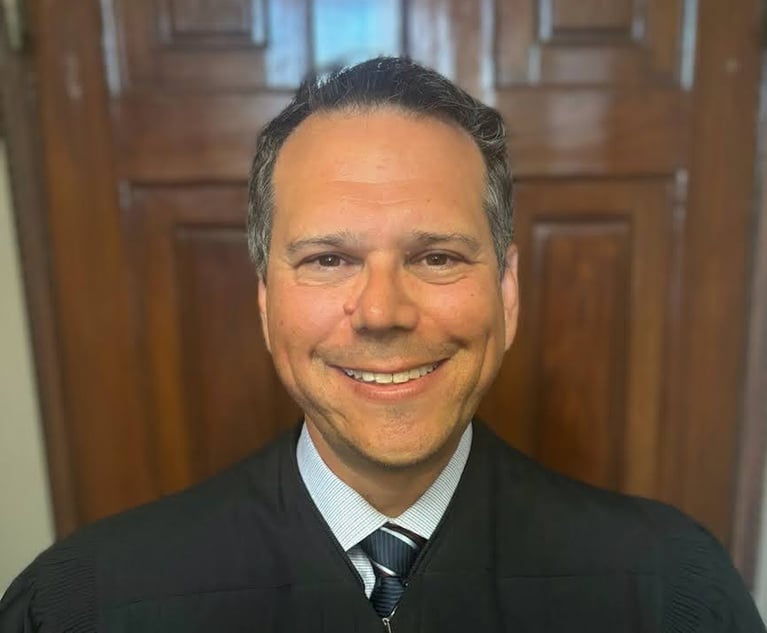 Protesters stream by the U.S. Supreme Court in 2017 as part of a women's march in Washington. Photo: ALM Media
Protesters stream by the U.S. Supreme Court in 2017 as part of a women's march in Washington. Photo: ALM MediaIn 1992, the Justices Had 5 Votes to Overturn 'Roe.' Why That Didn't Happen.
The Casey case, which affirmed Roe's central holding, is getting renewed attention for the standard the decision set for determining whether a state law posed an "undue burden" on a woman's right to get an abortion.
May 16, 2019 at 03:02 PM
6 minute read
The original version of this story was published on National Law Journal
In 1992, anti-abortion groups thought they had a winning case in defense of a restrictive Pennsylvania state law. There appeared to be five votes on the U.S. Supreme Court to overrule the landmark decision Roe v. Wade, but that did not happen. As Alabama and Missouri lawmakers adopt strict anti-abortion laws, and predict successful outcomes at the high court, history provides some lessons: Never bet on what occurs behind the high court's closed conference doors.
After oral arguments in Planned Parenthood of S.E. Pennsylvania v. Casey, Justices Harry Blackmun and John Paul Stevens believed the 1973 ruling in Roe was doomed.
Stevens, writing in his newly published book, “The Making of a Justice,” said the justices, except for him and Blackmun, agreed the U.S. Court of Appeals for the Third Circuit correctly upheld all of the challenged abortion restrictions—save for one, which required a married woman to certify she had notified her husband of her intent to have an abortion.
The Casey case, which affirmed Roe's central holding, is getting renewed attention today for the standard the decision set for determining whether a state law posed an “undue burden” on a woman's right to get an abortion. The justices are weighing several abortion-related challenges, and separately, new laws passed by Alabama and other Republican-led states could tee up direct challenges to Roe in the coming months.
Several new books, including the one from Stevens, offer a glimpse behind the scenes at how the Pennsylvania case was resolved and why caution is warranted in predicting the outcome in the most contentious cases.
“Harry and I both assumed that the result [in Casey] would be explained in an opinion overruling Roe v. Wade,” Stevens wrote in his autobiography, published this week.
In fact, at the justices' private conference, Chief Justice William Rehnquist counted five votes to reverse Roe, and he assigned the court's opinion to himself, according to journalist Evan Thomas in his new book, “First,” a biography of Sandra Day O'Connor.
 Justice Anthony Kennedy in March 2015 on Capitol Hill. Photo: Diego M. Radzinschi/National Law Journal
Justice Anthony Kennedy in March 2015 on Capitol Hill. Photo: Diego M. Radzinschi/National Law Journal
Rehnquist circulated a draft opinion for the court May 27, 1992, “that met our expectation—it did not expressly overrule Roe, but like his proposed opinion in the Webster case three years earlier, it effectively repudiated its central holding,” Stevens said in his book.
Two days later, then-Justice Anthony Kennedy sent a letter to Blackmun in which he asked to see the justice to convey some developments in the Casey case and some “welcome news.” Unknown to Blackmun and Stevens, Kennedy and justices O'Connor and David Souter had been meeting secretly to draft an opinion that would preserve Roe.
O'Connor “understood that it took some courage for the Catholic Kennedy to countenance any compromise or middle way on abortion rights,” according to the book that Thomas wrote about O'Connor. She and Souter had persuaded Kennedy to change his initial conference vote and to take a personal risk “by appealing to his basic sense of decency and fairness”—and, perhaps most importantly, his strong belief in individual liberty.
Kennedy would begin the three justices' joint opinion by writing: “Liberty finds no refuge in the jurisprudence of doubt.”
Their draft opinion circulated June 3, 1992, just one week after Rehnquist believed his draft would be the court's opinion.
Stevens said he asked the “troika” of justices for some minor changes so that he could join their opinion. His changes were accepted. “In my view, an opinion that begins as an opinion of the court and continues to speak for the court for 25 pages would be far more powerful than one that starts out as a plurality opinion and shifts back and forth between a court opinion and a plurality opinion.”
The Supreme Court of today, of course, is not the same as yesteryear. Kennedy retired last year, and he was replaced by Brett Kavanaugh, a longtime Washington federal appeals judge who observers expect could take a hard line against pro-abortion arguments.
Chief Justice John Roberts Jr. now becomes the central focus in abortion cases, mainly because of his concern that the court not be viewed as a partisan institution. But he has never voted to strike down a state abortion restriction.
 Justice Neil Gorsuch, left, and Chief Justice John Roberts Jr., walk down the steps of the U.S. Supreme Court after Gorsuch's investiture in January. Photo: Diego M. Radzinschi/ALM
Justice Neil Gorsuch, left, and Chief Justice John Roberts Jr., walk down the steps of the U.S. Supreme Court after Gorsuch's investiture in January. Photo: Diego M. Radzinschi/ALM
In the high court's most recent abortion decision—Whole Woman's Health v. Hellerstedt in 2016—Roberts joined the dissenters in a 5-3 decision that invalidated Texas's restrictions on abortion clinics and their physicians. The opening lines of Justice Stephen Breyer's majority ruling cited the 1992 Pennsylvania abortion ruling.
More recently, Roberts joined the court's liberal wing in February to block temporarily Louisiana clinic restrictions nearly identical to the Texas law. His vote, in the case June Medical Services v. Gee, was not on the merits of the challenge. The majority's action only stayed the effective date of the law until the challengers filed and the court acted on a petition for review.
The Pennsylvania abortion case isn't the only example of how conference votes may change dramatically and upset widespread expectations. The most recent example is Roberts's role in the court's review of President Barack Obama's signature policy initiative—the Affordable Care Act.
Roberts initially voted in the justices' secret conference to strike down the individual mandate to purchase health insurance and to uphold the expansion of Medicaid. Two months later, as Joan Biskupic reports in her new book, “The Chief,” Roberts shifted positions on both.
While predictable in some areas of the law, the Supreme Court is often most unpredictable in areas where its institutional credibility is at stake. In 2012, Justice Ruth Bader Ginsburg had the wisest advice for court watchers during those situations: “It ain't over till it's over.”
Read more:
This content has been archived. It is available through our partners, LexisNexis® and Bloomberg Law.
To view this content, please continue to their sites.
Not a Lexis Subscriber?
Subscribe Now
Not a Bloomberg Law Subscriber?
Subscribe Now
NOT FOR REPRINT
© 2025 ALM Global, LLC, All Rights Reserved. Request academic re-use from www.copyright.com. All other uses, submit a request to [email protected]. For more information visit Asset & Logo Licensing.
You Might Like
View All
Litigators of the Week: Simpson Thacher and ACLU Team To Challenge Louisiana's Ten Commandments Law

A Reporter and a Mayor: Behind the Scenes During the Eric Adams Indictment News Cycle

Even With New Business Courts, Texas Is a Long Way from Taking Delaware's Corporate Law Mantle
5 minute read
Trending Stories
- 1You Too Can Be a Programmer: Connecting to Legal Platform APIs With Generative AI (Part 2)
- 2Court of Appeals and Appellate Division As Courts of First Instance
- 3Federal Judge Slaps Down the SEC’s Attempt to Regulate Crypto Liquidity Providers
- 4A Client Is Guilty; But Another Man Is Wrongfully Convicted
- 5Legal Tech's Predictions for Cybersecurity in 2025
Who Got The Work
Michael G. Bongiorno, Andrew Scott Dulberg and Elizabeth E. Driscoll from Wilmer Cutler Pickering Hale and Dorr have stepped in to represent Symbotic Inc., an A.I.-enabled technology platform that focuses on increasing supply chain efficiency, and other defendants in a pending shareholder derivative lawsuit. The case, filed Oct. 2 in Massachusetts District Court by the Brown Law Firm on behalf of Stephen Austen, accuses certain officers and directors of misleading investors in regard to Symbotic's potential for margin growth by failing to disclose that the company was not equipped to timely deploy its systems or manage expenses through project delays. The case, assigned to U.S. District Judge Nathaniel M. Gorton, is 1:24-cv-12522, Austen v. Cohen et al.
Who Got The Work
Edmund Polubinski and Marie Killmond of Davis Polk & Wardwell have entered appearances for data platform software development company MongoDB and other defendants in a pending shareholder derivative lawsuit. The action, filed Oct. 7 in New York Southern District Court by the Brown Law Firm, accuses the company's directors and/or officers of falsely expressing confidence in the company’s restructuring of its sales incentive plan and downplaying the severity of decreases in its upfront commitments. The case is 1:24-cv-07594, Roy v. Ittycheria et al.
Who Got The Work
Amy O. Bruchs and Kurt F. Ellison of Michael Best & Friedrich have entered appearances for Epic Systems Corp. in a pending employment discrimination lawsuit. The suit was filed Sept. 7 in Wisconsin Western District Court by Levine Eisberner LLC and Siri & Glimstad on behalf of a project manager who claims that he was wrongfully terminated after applying for a religious exemption to the defendant's COVID-19 vaccine mandate. The case, assigned to U.S. Magistrate Judge Anita Marie Boor, is 3:24-cv-00630, Secker, Nathan v. Epic Systems Corporation.
Who Got The Work
David X. Sullivan, Thomas J. Finn and Gregory A. Hall from McCarter & English have entered appearances for Sunrun Installation Services in a pending civil rights lawsuit. The complaint was filed Sept. 4 in Connecticut District Court by attorney Robert M. Berke on behalf of former employee George Edward Steins, who was arrested and charged with employing an unregistered home improvement salesperson. The complaint alleges that had Sunrun informed the Connecticut Department of Consumer Protection that the plaintiff's employment had ended in 2017 and that he no longer held Sunrun's home improvement contractor license, he would not have been hit with charges, which were dismissed in May 2024. The case, assigned to U.S. District Judge Jeffrey A. Meyer, is 3:24-cv-01423, Steins v. Sunrun, Inc. et al.
Who Got The Work
Greenberg Traurig shareholder Joshua L. Raskin has entered an appearance for boohoo.com UK Ltd. in a pending patent infringement lawsuit. The suit, filed Sept. 3 in Texas Eastern District Court by Rozier Hardt McDonough on behalf of Alto Dynamics, asserts five patents related to an online shopping platform. The case, assigned to U.S. District Judge Rodney Gilstrap, is 2:24-cv-00719, Alto Dynamics, LLC v. boohoo.com UK Limited.
Featured Firms
Law Offices of Gary Martin Hays & Associates, P.C.
(470) 294-1674
Law Offices of Mark E. Salomone
(857) 444-6468
Smith & Hassler
(713) 739-1250






